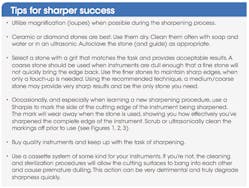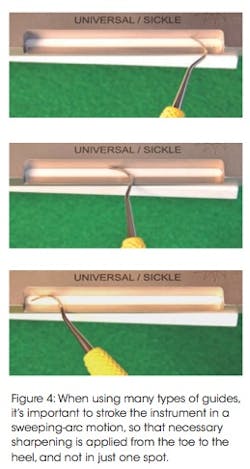The new instruments are great, aren’t they? You’re like a gourmet cook with new cutlery. There’s nothing better than sharp instruments. They facilitate better results with less effort. Calculus seems to fly off. Patients say you’re so gentle. Your employer commends you. Life is good.
And then, a little too soon, the instruments lose a little bit of their edge. Your efforts go up. Your hands and other body parts start to ache. Your chiropractor is on your speed dial. Calculus seems to burnish rather than pop off. The patients think you’re a little rough. Time gets harder to manage. You need more time to be effective. The dentist seems less happy with you. Oh, no! It’s time to sharpen instruments, possibly prompting an anxiety attack.The sharpening stone comes out, along with some oil. You learned this in school. How could it be so complicated? What were those angles again?
You’re doing this on your own time. It’s not like the boss has set aside special time for you to do this. Month after month, this goes on. How long before you get new instruments? Maybe you should just get these instruments retipped. The retipped instruments are not of the quality you would prefer. The shapes of the tips are not great, and they don’t hold an edge well at all. Telling the employer that you need new instruments is not going to fly.
Can you relate to the above?
Why is sharpening so difficult?
To begin with, inadequate understanding and training is often the norm. How much time did you spend on sharpening in hygiene school? Methods of sharpening have not changed much for a long time. This is not a dig at your hygiene instructors; it’s just the way it is. Here’s how many hygienists are currently sharpening instruments:
• For sickles and curettes, the instrument is held in one hand in a somewhat vertical position, with the blade to be sharpened at the bottom. The terminal shank of the blade to be sharpened is to be absolutely vertical, with the edge to be sharpened facing to your right.
• Using a stone with appropriate lubrication (oil or water, depending on the stone), vertically abrade the edge with the stone held at a 15 to 20 degree angle to the terminal shank of the instrument. Continue with sharpening motions from the heel to the toe.
• A Gracey’s edge is sharpened at a different angle from the terminal shank — 30 to 40 degrees.
• The toe of a curette is to be...
Stop! Stop!
Expecting a human to hold an instrument in an absolute position in one hand, while sharpening it with the opposite hand at a near-perfect angle, is nearly infeasible. Human dexterity does not allow this to happen. It would be a very special person who could accomplish this effectively.
Sharpening an instrument with an abrasive moved at right angles to the edge transfersMore bad news. Moving the stone up and down at right angles to the contoured edge of instruments can create facet-like results that are very difficult to blend smoothly (see Figures 1, 2).
Then there’s the theory that using an oil or water lubricant will float metal debris away and prevent it from being embedded in the stone. While it’s true that a constant flow of lubricant may flush metal shavings away from the abrasive, this is not practical. Conventional use of a lubricant creates a slurry on the stone that actually impedes the sharpening process.
The Bottom Line
You’re being expected to pull off a miracle. Sharpening anything, in general, is not an easy task. How are your kitchen knives looking? Are they as sharp as new? I’ve been a professional knife maker and tool sharpener for many years. I can assure you that I generally cannot sharpen effectively by freehand methods! It’s not impossible, but darn near it.
My belief is that freehand sharpening takes too long, is too difficult for mortal humans to perform, and most often delivers substandard results, creating mega- frustration.
Maybe you should utilize a professional sharpening service. Instrument manufacturers and sharpening services utilize professional sharpening staff who undergo extensive training to become proficient. The downside is that you would have to inventory many, many instruments to compensate for rotation of instruments to and from the sharpening service. Also, there is risk that the temper of the instruments could be compromised by less than professional services, or that the original shape of the instrument could be altered. Still, this is an option to be considered. In some cases, this is a very viable solution.
My best advice is to consider sharpening on your own with an instrument-sharpening device that will guide your efforts to success. In other industries, the sharpening of cutting edges is often performed with a fixture or guide that contributes greatly to the procedure. Sharpening aids available to the dental hygiene community include:
• InstRenew Sharpening Assistant (Nordent Mfg., Inc.)
• Sharpening Horse (DH Methods of Education, Inc.)
• Sidekick Sharpening Kit (Hu-Friedy)
• D.I.S.C. Sharpener (Premier Dental)
• Ultimate Edge Sharpening Kit (Paradise Dental Technologies/PDT)
ADDITIONAL Information |Instrument sharpening insights from PDT
Do some research, and select an instrument guide that will positively take the guesswork out of sharpening instruments at correct angles. The best sharpening procedure utilizes a motion that sharpens the edge on the same plane as the edge itself, not perpendicular to it. A means of shaping the toe of curettes is vital. Explore the available products to see which will work best for you (see Figures 2, 3, 4).
Who’s Got The Time?
Repeatedly, hygienists say that they struggle to find the time to sharpen. The answers to the mechanics of sharpening can be taught in a black-and-white manner. Time management issues are shades of gray that are subjective, and not solvable by any single description.
Within my clinic presentations, this subject is discussed in an open discussion environment. I feel this encourages unique solutions to unique situations. I’ve heard many of the challenges hygienists experience in finding time for instrument maintenance. “I don’t have time to sharpen chairside.” “My doctor expects me to do this on my own time.” My personal favorite is, “My employer doesn’t like the sound when I sharpen.”
What we can all agree on is the necessity of instrument maintenance. Neglecting instruments is a lose/lose proposition. Everyone loses — you, the patient, and the employer. Although providing absolute answers for you is beyond the scope of this article, I can offer direction.
• Decide when the best time to sharpen is for your situation.
• You must communicate with your employer about how important sharpening is and present your plan. The employer must absolutely embrace your conviction to adequately maintain your instruments. Between the two of you, find resolve.
• Commit to the plan. Need I say more? This just has to happen.
• Finally, the very best advice I can offer is to encourage your employer to read this article. It will go a long way toward the relationship necessary to achieve a top-notch hygiene program.
Stay sharp, my friends!










